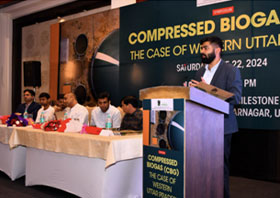 |
Dear Readers,
Globally, India ranks fourth in renewable energy capacity, with 145 GW of installed capacity (excluding large hydro-power), as per data with the Union Ministry of New and Renewable Energy (MNRE). Government programmes in bioenergy, wind and solar power have driven these advancements. To sustain this growth, the country needs a thorough assessment of the barriers to clean energy transition, focusing on implementation challenges in each sector.
Q1 of this year has seen unprecedented growth in the renewable energy space, especially solar, with 10 GW of solar energy capacity added in this quarter alone. This is a significant jump from the 18 GW capacity added in all of last year. However, it needs to be kept in mind that almost all the growth in solar energy has been from utility-scale models; adoption rates in solar rooftop segments are considerably low. Currently, rooftop solar contributes nearly 13 GW, with only 30 per cent from the residential sector. The PM Surya Ghar Yojana is expected to improve the contribution between these two segments.
With the Approved List of Models and Manufacturers (ALMM) order being reimposed for this year, it is expected that domestic manufacturing of solar modules will increase as imports from China decrease. While abeyance of this order worked in solar developers’ favour in the last year, this reimposition may also translate to an increase in prices of solar modules as domestic modules are more expensive than the ones imported from China despite the heavy custom duties.
In terms of offshore wind energy, India’s vast coastline holds the potential of generating 70 GW of wind power. But so far, India does not have any offshore wind projects. The approval of Viability Gap Funding (VGF) is a welcome development, expected to kickstart development of offshore wind projects in the country. A total outlay of Rs 7453 crore will help finance installation and commissioning of 1 GW of offshore wind energy projects with the potential to generate 3.72 billion units of renewable electricity annually.
Similarly, in the Compressed Biogas Segment, Fermented Organic Manure (FOM) is gaining more traction as evident from the release of the Standards of Procedures guidelines for quality checking of bioslurry. People have been unaware of fermented organic manure (FOM), a by-product of CBG, so far. The release of these guidelines and the official acknowledgement from the Government has the potential to motivate farmers to use the bioslurry generated from CBG plants to make FOM.
The first quarter has seen positive developments in several renewable energy segments. It is hoped that this pace is sustained in the coming months.
Renewable Energy, CSE |
|
 |
| |
 |
|
| |
|
|
| |
 |
|
| |
|
|
| |
 |
|
| |
|
|
| |
 |
|
| |
|
|
| |
|
|
| |
|
|
| |
|
|
| |
|
|
| |
|
|
| |
|
|
| |
 |
|
| |
| CSE TRAININGS |
| |
|
|
|
|
 |
|
|
|
|
|
|
| |
 |
|
| |
|
|
| |
|
|
| |
 |
|
|
CSE PUBLICATIONS |
|
| |
|
|
| |
|
|
| |
|
|
| |
|
|
|
NEWS |
|
| |
|
|
| |
|
|
| |
 |
|
| |
|
|
| |
|
|
| |
 |
|
| |
|
|
| |
|
|
| |
|
|
| |
|
|
| |
|
|
| |
|
|
| |
|
|
| |
|
|
| |
|
|
| |
 |
|
| |
Get other CSE Newsletters in Your Inbox |
|